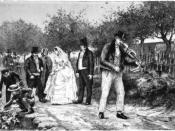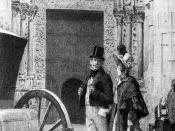In these two books, 'Madame Bovary' and 'Therese Raquin', the author's use characters for particular symbolic effect. In 'Madame Bovary' there are two extremely minor characters that play important role's in Flaubert's comment about Emma and her life, whilst in 'Therese Raquin' the character of Camille's ghost is similarly used to reflect on the reality of the lives of the two lovers. However, unlike the two minor characters in 'Madame Bovary', Camille's ghost appears in most of the book.
In 'Madam Bovary' Flaubert introduces the organ grinder early on in the novel. He appears suddenly to Emma's view from outside a window. Flaubert makes sure that the reader imagines this person as an unattractive being, ". . . a swarthy black-whiskered face would appear at the living-room window", yet also he has white teeth, an ironic contrast for this kind or person.
After Flaubert finishes describing this man's conflicting appearance he describes the music that he plays, which contrasts with his appearance, as it is very beautiful and pleasant. He then proceeds to describe the organ, "..in a miniature drawing-room set out on top of a barrel-organ, [there were] dancers the size of your finger - women in pink turbans,"
The disturbing appearance and attitude of the organ grinder - "Occasionally he shot a long stream of dark saliva at the kerbstone.."- is there as a symbol of Emma's reality that nothing she desires every happens, and that she is always disappointed with her life. In this way Flaubert is able to alert the reader to Emma's life and how her fantasies always contrast with reality, he does this so that he can emphasize the importance of this irony of Emma's life, pointing out to the reader that although he...



Madame Bovary and Therese Raquin
Thanks for a good essay comparing Flaubert's use of the organ grinder and the blind beggar in Madame Bovary and Zola's use of Camille's ghost in Therese Raquin. Flaubert and Zola were two masters of using characters symbolically and your fine essay underscores that point. Nice work! Of course, it's only necessary to submit your essay once.
5 out of 5 people found this comment useful.